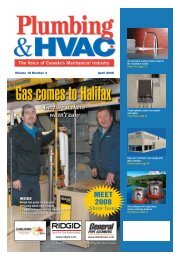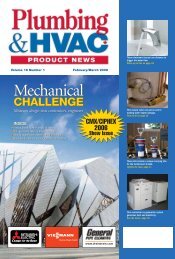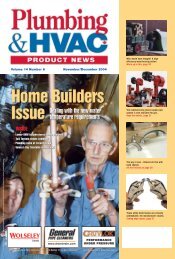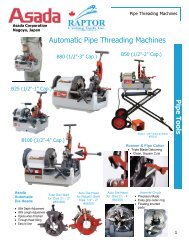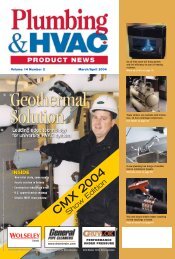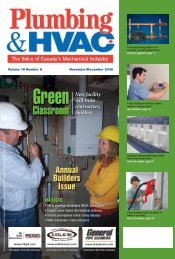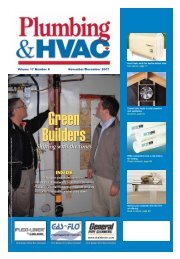INSIDE INSIDE - Plumbing & HVAC
INSIDE INSIDE - Plumbing & HVAC
INSIDE INSIDE - Plumbing & HVAC
Create successful ePaper yourself
Turn your PDF publications into a flip-book with our unique Google optimized e-Paper software.
Industry News<br />
New National <strong>Plumbing</strong><br />
Code offers flexibility<br />
By Ron Shuker<br />
Contractors and engineers will have<br />
more flexibility in the design and<br />
installation of plumbing systems<br />
under the 2005 model National<br />
Building, <strong>Plumbing</strong> and Fire Codes<br />
released at the end of September. At<br />
least that’s what officials at the<br />
Canadian Commission on Building and<br />
Fire Codes are saying about the new<br />
objective–based codes.<br />
As well, almost 1300 technical changes<br />
have been made to the previous editions<br />
since they were published in 1995.<br />
Mobile worker<br />
shortage studied<br />
Astudy recently completed by the<br />
Construction Sector Council reveals<br />
why it is becoming increasingly<br />
difficult to find workers that are<br />
willing to move from jobsite to jobsite.<br />
“Mobile workers are generally a dissatisfied<br />
group and the construction<br />
industry, particularly the industrial sector,<br />
could suffer because of it,” reports<br />
Bob Blakely, CSC labour co-chair and<br />
director of the Canadian Affairs for the<br />
Building and Construction Trades<br />
Department, AFL-CIO.<br />
It’s not hard to see why. The typical<br />
mobile worker “is married, with at least<br />
two children under the age of 18 years,<br />
and his working mobile has a net-negative<br />
impact on his marriage and family,”<br />
reports the study, Working Mobile: A<br />
Study of Labour Mobility in Canada’s<br />
Industrial Construction Sector.<br />
To make matters worse, mobile<br />
workers are often regarded with the<br />
suspicion that they are taking local jobs<br />
by the communities where they work<br />
and they don’t receive the tax breaks<br />
that other mobile workers, such as<br />
truckers, receive. See the full report at<br />
www.csc-ca.org.<br />
Together, designers and installers<br />
have reason to be optimistic about the<br />
innovative alternatives they can adopt<br />
once the new code is adopted by each<br />
province and territory, reported Raman<br />
Chauhan, technical advisor at the Codes<br />
Centre of the National Research<br />
Council in Ottawa during an address to<br />
the Ontario <strong>Plumbing</strong> Inspectors<br />
Association Annual Meeting, held Sept.<br />
19-21 in Oshawa, Ont. These changes<br />
address many technological advances<br />
along with health and safety concerns.<br />
The old prescriptive code simply stated<br />
that: “You have to do it this way or<br />
that way. There is no other acceptable<br />
way,” explained Chauhan. Objectivebased<br />
codes outline the problem the<br />
code determines to solve, describe the<br />
objective(s) to solve the problem and<br />
leave the actual determination of a solution<br />
to the system designers.<br />
Chauhan said, for example, the code<br />
requirement is to ensure public safety in<br />
the use of toilets. The objective is to<br />
ensure a toilet does not collapse when<br />
used. The designer must select the fixture<br />
and the method of installation so it<br />
won’t fail. A simple way of meeting this<br />
requirement is to ensure the toilet complies<br />
with a recognized standard. In the<br />
case of toilets, the CSA B-45 standard is<br />
referenced in the NPC.<br />
A big concern with performance<br />
codes was the need for performance<br />
standards. “These can take decades to<br />
develop and establish as valid and consistent.<br />
Many code requirements lacked<br />
that performance data,” he said. “Now<br />
there is additional information in the<br />
objectives to help evaluate equivalents,”<br />
he added.<br />
What has not been publicized is how<br />
this code ties into new provincial<br />
(Ontario and B.C., for example)<br />
mandatory upgrades and certification<br />
of designers. That goal is to ensure<br />
accuracy in drawings and permit applications,<br />
and speed up the approval<br />
process. It also means mandatory use of<br />
the provincial building permit application<br />
form, Al Suleiman, acting manager,<br />
code interpretation, regulation and<br />
training, Ministry of Municipal Affairs<br />
& Housing, told OPIA members.<br />
continued from page 7<br />
of the art air and vapour barriers<br />
for improved insulation. Energy<br />
savings of 30 to 40 percent a year<br />
are expected.<br />
Apprenticeship study<br />
launched<br />
The Canadian Apprenticeship<br />
Forum has launched an apprenticeship<br />
study that is expected to<br />
be broader in scope than previous<br />
surveys. It will provide employers,<br />
apprentices, governments and<br />
educational facilities cost and benefit<br />
information on a wide range of<br />
apprenticeship trades, reports<br />
project manager Arlene Wortsman.<br />
Circle Number 110 for More Information




